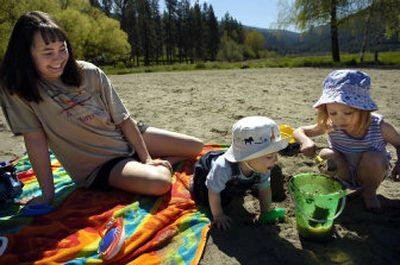Prime park time

You don’t have to spend hours behind the wheel to find an outdoor wonderland offering wildlife, a glacial lake and recreational opportunities.
It’s all waiting for you at Liberty Lake County Park.
One of the largest county parks in the Northwest, it encompasses nearly 3,000-acres of mixed terrain and boasts a history of which any Westerner would be proud.
“One of the real neat aspects of this park is that it’s close. You can feel like you’re away from it all out here and still only be about 20 or 30 minutes away from home,” said Bryant Robinson, the park’s ranger who lives on-site with his family.
Each year, the park draws RVs, tent campers, beachgoers, kayakers, hikers, picnickers, wildlife lovers and ORV enthusiasts.
Off-peak, it hosts environmental programs for youngsters, activities for scouts and high school cross country meets.
Summer activities kick into high gear Memorial Day and continue through Oct. 15.
That’s when recreational vehicles will begin rolling into 21 slightly elevated campsites with beautiful views, water and electrical hookups, picnic tables and either assigned fire pits or barbecue grills. “We limit their stays to a week,” Robinson said. Close by are grassy spots for 11 tents, available to campers on a first-come, first-served basis. Parking pads, picnic tables and barbecue grills or fire pits are also at each tent site.
Restrooms with flush toilets and a shower house with hot water are near the camping spots. Day campers will find lots of picnic tables, shade trees and horseshoe pits.
Sunny days bring throngs of beachgoers. They love to cool off in the lake’s marked swimming area under the eyes of lifeguards. In addition to a sandy beach, this section boasts a playground, a sprawling lawn for picnics and changing rooms with sinks and toilets.
There’s even a small dock from which people can fish, land kayaks and canoes or hop aboard paddle boats, Robinson said.
Just up the peak, 16 miles of trails crisscross 350 acres of forest set aside for all-terrain vehicles, some kinds of four-wheelers and dirt bikes. The ORV park encompasses mixed terrain, from gentle to steep slopes, mud bogs, hill climbs and scenic rides. This year, color-coded signs depicting difficulty ratings – from easy to moderate and difficult – are being posted at trail heads.
Spokane County’s Parks and Recreation Department received millions of dollars in grants through the Interagency Committee for Outdoor Recreation to improve and patrol the area.
Funds helped pay for the addition of a parking and vehicle loading area, a new fence, restroom, signs and beefed-up patrols and educational efforts.
Weather permitting, the ORV park is open year-round from 8 a.m. to a half-hour before dusk. Riders under the age of 16 should be accompanied by an experienced rider 18 or older.
ORV permits and current Washington state license tags are required. No cars, dune buggies, jeeps or pickup trucks are allowed on the trails. Riders are expected to observe all state and county ORV rider and vehicle equipment requirements, including approved helmets and eye protection. Just up the road is a trail head for those who wish to ride horses on about 10 miles of park trails.
Newcomers are advised to contact Robinson before they nose their steeds into the woods.
“Trails are not marked outside the main loop. Riders come with someone who knows the areas, or I call members of the Backcountry Horsemen or Trailmakers groups and they’ll meet them out here,” he said.
An eight-mile trail loop, featuring a series of waterfalls, old growth cedar trees, and natural landscapes appeals to those who prefer to explore the park on foot. Informational signs are posted at about mile intervals.
“This is the big loop most people do. It goes from a nice easy walk to heavy exertion. I don’t want to mislead anybody, there are sections in there that are just darn tough,” Robinson said, nodding his head in the direction of a main foot path.
“It takes the average hiker about four hours,” he said. “Be prepared. Bring water, snacks, bug repellant, hiking boots, long socks and long-sleeved shirts if you’re worried about ticks and mosquitoes. And it’s always nice to have sunscreen and eye protection.”
Wildlife lovers may spot moose, elk, signs of an elusive black bear, cougars, lynx, and a wide variety of birds. Stroll down the wooden boardwalk over the park’s sprawling marsh for an up-close peek at cattails, red-winged blackbirds, herons, frogs and other swamp dwellers.
Animal watching is best conducted early mornings and just before sundown at times when fewer people are using the park.
In the heart of the park, a popular, rustic picnic pavilion is available for reservations. Nearby, benches line a natural slope that shelters a wooden amphitheater perfect for public presentations. Corporations, including Agilent Technologies, as well as Eagle Scouts, community groups and other volunteers annually donate countless hours maintaining and improving the park grounds and its facilities, Robinson said.
“It’s truly a community effort. It makes a huge positive impact when I can get volunteer time and labor out here. A big thank you to all of them,” he said.
The area has a rich history. Montana gambler Charlie Traeger helped tame the area when he built the Zephyr Inn roadhouse near the lake in the early 1900s.
Later, his wife transformed the place into a summer resort. In the 1930s, rancher Florence M. Miller established a cattle farm on the property, which after his death was purchased for use as a county park.